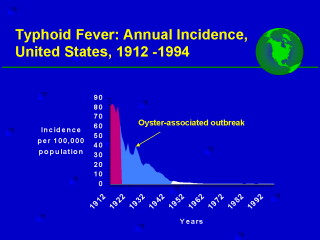|
|
|
|
front |1 |2 |3 |4 |5 |6 |7 |8 |9 |10 |11 |12 |13 |14 |15 |16 |17 |18 |19 |20 |21 |22 |23 |24 |25 |26 |27 |28 |29 |30 |review |
 |
There
was still plenty of typhoid fever in the US during the second period which
starts out "spikey" and eventually takes the shape of a moderately
steep and even decline.
The annotated spike represents a multistate outbreak in which over
1,500 people contracted typhoid from eating raw oysters.
Investigations of outbreaks like this, repeatedly implicated
particular foods as vehicles of typhoid transmission.
Raw oysters harvested from sewage contaminated waters, unpasteurized
milk contaminated by asymptomatically infected milkmaids, and fresh
vegetables fertilized with fresh night soil were most often implicated.
Three
activities in the 1920's, 30's, and 40's brought the foodborne period of
typhoid transmission to an end: legal reforms related to shellfish
sanitation, pasteurization, and farming practices; tracking by public health
personnel of asymptomatic typhoid carriers who were prohibited from working
as food handlers; and the introduction of effective antimicrobial therapy.
Any
thoughts on why the incidence of typhoid fever in the US has increased since
the mid 1950s?
|